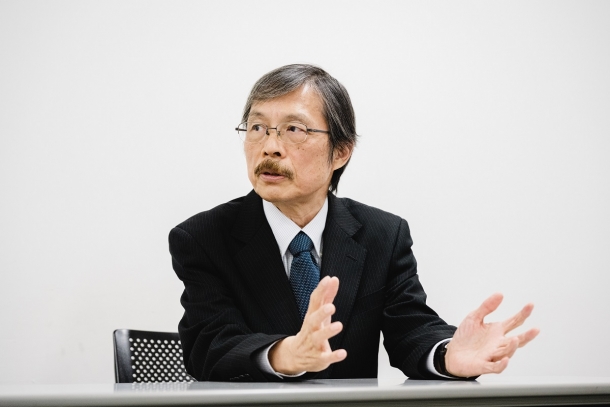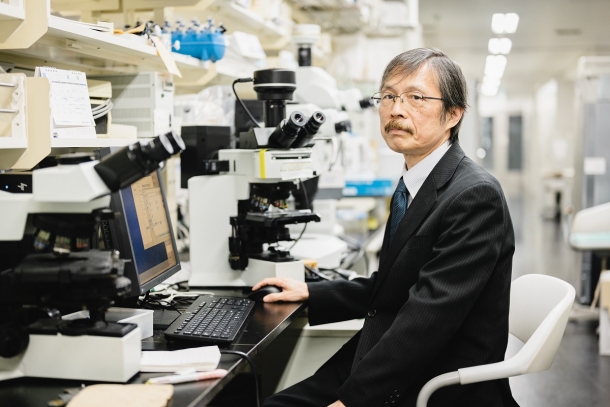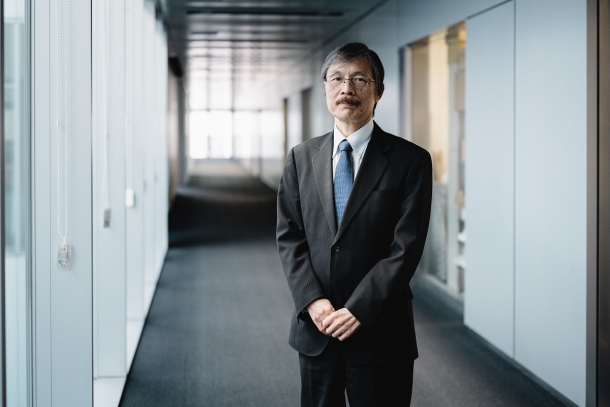- その他
- 神経発生の知見を生かして神経難病の治療を目指す / Aiming to treat intractable neurological disorders by using knowledge of neuronal development【先進理工学部 生命医科学科・大島登志男教授】
神経発生の知見を生かして神経難病の治療を目指す / Aiming to treat intractable neurological disorders by using knowledge of neuronal development【先進理工学部 生命医科学科・大島登志男教授】

- Posted
- 2023年2月15日(水)

神経の発生で見つかった現象を神経の再生に応用
先進理工学部 生命医科学科の大島登志男教授は、山梨医科大学医学部を卒業後、神経内科のドクターとして5年間勤務していた。しかし、神経内科で扱う病気は治療が難しいものが多く、また当時は原因がわからないものも多かったため、そうした病気の治療を目指して基礎研究の道に進むことにした。当初は神経の発生や脳の発達について研究をしていたが、2007年に早稲田大学に来てからはそれまでの知見を生かして、神経の再生や神経疾患の治療に関する研究に取り組んでいる。
「神経の発生や脳の発達については、いろいろな新しい知見があります。そうした知見を利用して、脊髄損傷や視神経損傷など、傷ついた神経を再生させる研究に取り組んできました。また、その延長として、神経疾患の治療にも取り組んでいます。神経の発生で見つかった現象を神経の再生に応用するのが、私のオリジナリティだと思っています」(大島教授)
脊髄を損傷すると神経の軸索が切れてしまうが、そのおおもとの細胞は脳にある。そこで脳における遺伝子の変化を調べ、特定の遺伝子を改変したモデルマウスを作って実験したところ、脊髄損傷から回復しやすくなることが見出された。同様のことは視神経でも確認され、この発見を視神経の病気である緑内障へ応用する研究が進んでいる。しかし、遺伝子改変を人の治療に応用することは難しい。そのため、人の治療には同じような作用を持つ薬の利用が考えられている。

腸から脳へ
現在、大島教授が興味を持って取り組んでいるテーマのひとつが腸内細菌だ。
「アルツハイマー型認知症モデルマウスに抗生物質を投与すると、腸内の細菌叢が減ります。すると、脳内で作られるアミロイドβというタンパク質の量が減ることがわかりました。アミロイドβはアルツハイマー型認知症のもととなる物質で、これにより病変が改善することが見出されています。ただ、オスではアミロイドβが減るが、メスではあまり変化しなかったため、今、腸内細菌の解析に取り組んでいます」(大島教授)
これは腸脳相関と呼ばれる現象だ。例えば、食物繊維の多い食品をとると腸内の短鎖脂肪酸が増えるが、短鎖脂肪酸には脳の炎症を抑える作用がある。詳しいメカニズムはまだよくわかっていないが、このような効果がある食品や成分はプレバイオティクスと呼ばれており、様々な疾患で腸内細菌との関係が研究されている。
モデルマウスを使った実験では抗生物質を投与して腸内の細菌を減らしたが、現在、企業とともに取り組んでいるのは、食べ物によって腸内細菌叢を変化させて病気の進行を緩和させる研究だ。企業との共同研究のため詳しいことは教えてもらえなかったが、アルツハイマー型認知症に限らず、別の神経疾患についても取り組んでいるそうだ。

リポジショニングでハードルを下げる
大島教授の研究は、マウスでの治療効果を確実にすることであり、それを人の治療に結び付けるのは次の段階になる。その場合は、リポジショニングといって、他の病気で使われている治療薬を利用することを考えている。比較的臨床に応用しやすい薬を選び、治療したい病気に効果があることをマウスで示すことで、適用例を変えていく。すでに人に対する安全性が確認されている薬を使うため、臨床に応用するハードルは低いと考えられる。まだ具体的な道筋は描けていないが、研究に興味のある製薬会社からのアプローチなどがあれば、積極的に取り組んでいきたいという。
「神経の発生や脳の発達も、個人的には非常に興味が持たれる分野ではあります。ただ、生命医科学科には『人の役に立つ研究がしたい』『病気の治療をしたい』という学生が多く集まるため、そうした学生たちと話をしているうちに私自身も基礎研究の道に進んだころの気持ちに戻り、神経再生や神経疾患の治療といったテーマにシフトしてきたようなところはありますね」という大島教授。
神経難病は治療法がないという状況に近く、研究成果を発表すると、それがマウスに対する研究成果であっても、患者さんやその家族から「いつごろ使えるようになるのか」「治療を受けてみたい」という電話や手紙が来ることもあるそうだ。「そうした方々の声を聞くと、神経難病を治療できるようにしたいと思いますね。今はアルツハイマー型認知症やパーキンソン病を対象としていますが、将来はALSにも取り組みたいと思っています」(大島先生)
プロフィール
大島登志男 教授(先進理工学部 生命医科学科)
おおしま・としお/1962年生まれ。1986年山梨医科大学医学部医学科卒、90年同大学院博士課程修了。医学博士。91年国立精神・神経センター流動研究員、93年米国立衛生研究所(NIH)訪問研究員、98年理化学研究所脳科学総合研究センター研究員、04年同センター副チームリーダーを経て、07年から現職。21年、早稲田大学リサーチアワードを受賞。専門は神経科学一般、分子神経科学。
所属学会
日本神経化学会、日本分子生物学会
Applying the phenomena found in neuronal development to neuronal regeneration
Professor Toshio Ohshima of the Department of Life Science and Medical Bioscience in the School of Advanced Science and Engineering worked as a neurology doctor for five years after he graduated from the School of Medicine at the University of Yamanashi. However, there were many diseases that were difficult to treat through neurology, and there were many with causes that were unknown at the time, so he decided to pursue basic research with the goal of treating those diseases. At first, he studied neuronal development, and since he came to Waseda University in 2007, he has been researching neuronal regeneration and the treatment of neurological disorders.
“There is a lot of new knowledge surrounding neuronal development. We have been using this knowledge to work on research that will let damaged nerves regenerate from injuries such as spinal cord and optic nerve injuries. By extension, we are also working on treating neurological disorders. I believe that my originality is the application of the phenomena found in neuronal development to neuronal regeneration.” (Professor Ohshima)
When the spinal cord is damaged, the nerve axons are cut off, but the root cells remain in the brain. He studied genetic changes in the brain and created and experimented with mice models that had modified genes. Through this, he found a certain gene modification that made it easier to recover from spinal cord injury. He observed similar phenomena in the optic nerve and is researching how to apply this finding to glaucoma, a disease that damages the optic nerve. However, it is difficult to apply genetic modification to treatment of humans. For that reason, the use of drugs with similar effects are considered in the treatment of humans.
From the gut to the brain
One of the themes that Professor Ohshima is currently interested in is gut microbiota.
“When we gave antibiotics to a model mouse with Alzheimer’s disease, the amount of bacterial flora in their gut decreased. We found that when that happened, the depositions of amyloid β protein in the brain also decreased. Amyloid β is a substance that causes Alzheimer’s disease. Through this, we found that they improve lesions. However, the amount of amyloid β decreased in males, but did not change much in females, so we are now analyzing gut microbiota.” (Professor Ohshima)
This phenomenon is called a gut-brain interaction. For example, eating fiber-rich foods increases the amount of short-chain fatty acids in the gut. Short-chain fatty acids suppress inflammation of the brain. We still do not understand the details of the mechanism, but foods and ingredients that have such effects are called prebiotics, and their relationship with gut microbiota is being studied in various diseases.
In experiments with model mice, we administered antibiotics and decreased their intestinal bacteria. We are currently working with a company to research how to change bacterial flora in intestines through food, thereby inhibiting disease progression. We were not given any details because it is a joint research project with a company, but he is also working on studying other neurological disorders in addition to Alzheimer’s disease.
Lowering Hurdles through Repositioning
Professor Ohshima’s research aims to confirm the therapeutic effects in mice. The next step is to connect them to human treatment. For that purpose, he is considering repositioning, using drugs that are used for other diseases. By selecting a drug that is relatively easy to apply in a clinical setting and using mice to demonstrate that it is effective against the disease he wants to treat, he can change the application example. Since this involves the use of a drug that has already been confirmed to be safe for humans, the hurdles for clinical application can be considered low. Although he has not yet drawn a clear plan, he is eager to try it if he is approached by a pharmaceutical company that is interested in his research.
Professor Ohshima says, “I am personally very interested in the areas of neurogenesis and brain development. However, there are many students in the Department of Life Science and Medical Bioscience who want to do research that is useful to people and can treat diseases, and when I talk with these students, I sometimes recall the feelings I had when I was on the path of basic research and shift to themes such as neuronal regeneration and treatment of neurological disorders.”
There are almost no treatments for intractable neurological disorders, and when he publishes the results of his research, even though he uses only mice in his research, he sometimes receives phone calls or letters from patients or their family saying, “When will we be able to use this?” or “I want to try this treatment.” “When I hear those people’s voices, it makes me want to be able to treat intractable neurological diseases. We are currently focusing on Alzheimer’s disease and Parkinson’s disease, but I want to work on ALS in the future.” (Professor Ohshima)
Profile
Professor Toshio Ohshima (Department of Life Science and Medical Bioscience, School of Advanced Science and Engineering)
Born in 1962. Graduated from the Graduate School of Medicine, Faculty of Medicine, University of Yamanashi in 1986 and completed a doctoral course there in 1990. Doctor of Medicine. He worked as a postdoc researcher at the National Center of Neurology and Psychiatry from 1991 and a visiting researcher at the National Institutes of Health (NIH) from 1993. At the RIKEN Brain Science Institute, he worked as a researcher from 1998 and a deputy team leader from 2004. He has worked at Waseda University since 2007. He won a Waseda Research Award in 2021. He specializes in general neuroscience and molecular neuroscience.
Academic affiliations
The Japanese Society for Neurochemistry, the Japanese Society of Neurology, the Molecular Biology Society of Japan
- Tags
- 研究活動
